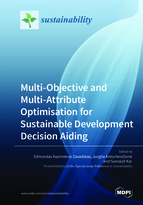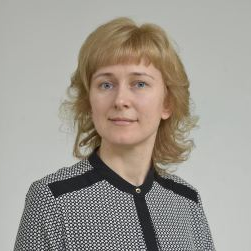Multi-Objective and Multi-Attribute Optimisation for Sustainable Development Decision Aiding
A special issue of Sustainability (ISSN 2071-1050).
Deadline for manuscript submissions: closed (28 February 2019) | Viewed by 91930
Special Issue Editors
Interests: operations research; optimization and decision analysis; multicriteria decision making; multiattribute decision making (MADM); decision support systems; civil engineering; energy; sustainable development; fuzzy sets theory; fuzzy multicriteria decision making; sustainability; management; game theory and economical computing knowledge management
Special Issues, Collections and Topics in MDPI journals
Interests: multi-criteria decision-making (MCDM); multiattribute decision making (MADM); operations research; decision support systems; multiple-criteria optimization in construction technology and management; decision making under uncertainty; fuzzy sets theory; civil engineering; sustainable development; sustainable construction; investments; knowledge management
Special Issues, Collections and Topics in MDPI journals
Interests: operations research; optimization; soft computing; uncertainty theory; financial modelling
Special Issues, Collections and Topics in MDPI journals
Special Issue Information
Dear Colleagues,
Optimization may be considered as a decision-making process to get the most out of available resources for the best attainable results. Many real-world problems are multi-objective (MOP) or multi-attribute problems (MAP) that naturally involve several competing objectives that are required to be optimized simultaneously, while respecting some constraints or selecting among feasible discrete alternatives. In contrast to single-objective optimization, the solutions of MOP and MAP correspond to a set of solutions with trade-offs, each expressing a particular compromise between the different objectives or attributes.
Moreover, decisions must often be taken in the face of the unknown. Actions decided upon in the present will have consequences that cannot fully be determined until a later stage. However, there may be openings for corrective actions later, or even multiple opportunities for recourse, as more and more becomes known. There is no surprise that with the ever increasing complexity of problems, optimization comes with an inherent facet of uncertainty conveyed in different formal ways and calls for innovative approaches to produce optimal and interpretable solutions.
In this Special Issue, researchers from academia and industries are invited to submit papers that explore aspects of multi-objective or multi-attribute modelling and optimization in crisp or uncertain environment, and will elaborate on the state-of-the-art case studies in selected areas of application related to sustainable development decision aiding.
The submitted papers should include the potential topics with crisp, uncertain or fuzzy data, but are not limited to:
- Multi-Stage Multi-Objective or Multi-Attribute Problem
- Multi-Objective or Multi-Attribute Time-Dependent Problem
- Granular Computing-Based Multi-Objective or Multi-Attribute Optimization
- Neural Networks-Based Multi-Objective or Multi-Attribute Optimization
- Multi-Objective or Multi-Attribute Network Optimization Problem
- Multi-Objective or Multi-Attribute Supply Chain Problem
- Multi-Objective or Multi-Attribute Business Intelligence Problem
- Multi-Objective or Multi-Attribute Financial Modelling
- Multi-Objective or Multi-Attribute Healthcare Modelling
- Multi-Objective or Multi-Attribute Intelligent Transport Modelling
Prof. Edmundas Kazimieras Zavadskas
Prof. Jurgita Antucheviciene
Assoc. Prof. Samarjit Kar
Guest Editors
Manuscript Submission Information
Manuscripts should be submitted online at www.mdpi.com by registering and logging in to this website. Once you are registered, click here to go to the submission form. Manuscripts can be submitted until the deadline. All submissions that pass pre-check are peer-reviewed. Accepted papers will be published continuously in the journal (as soon as accepted) and will be listed together on the special issue website. Research articles, review articles as well as short communications are invited. For planned papers, a title and short abstract (about 100 words) can be sent to the Editorial Office for announcement on this website.
Submitted manuscripts should not have been published previously, nor be under consideration for publication elsewhere (except conference proceedings papers). All manuscripts are thoroughly refereed through a single-blind peer-review process. A guide for authors and other relevant information for submission of manuscripts is available on the Instructions for Authors page. Sustainability is an international peer-reviewed open access semimonthly journal published by MDPI.
Please visit the Instructions for Authors page before submitting a manuscript. The Article Processing Charge (APC) for publication in this open access journal is 2400 CHF (Swiss Francs). Submitted papers should be well formatted and use good English. Authors may use MDPI's English editing service prior to publication or during author revisions.








